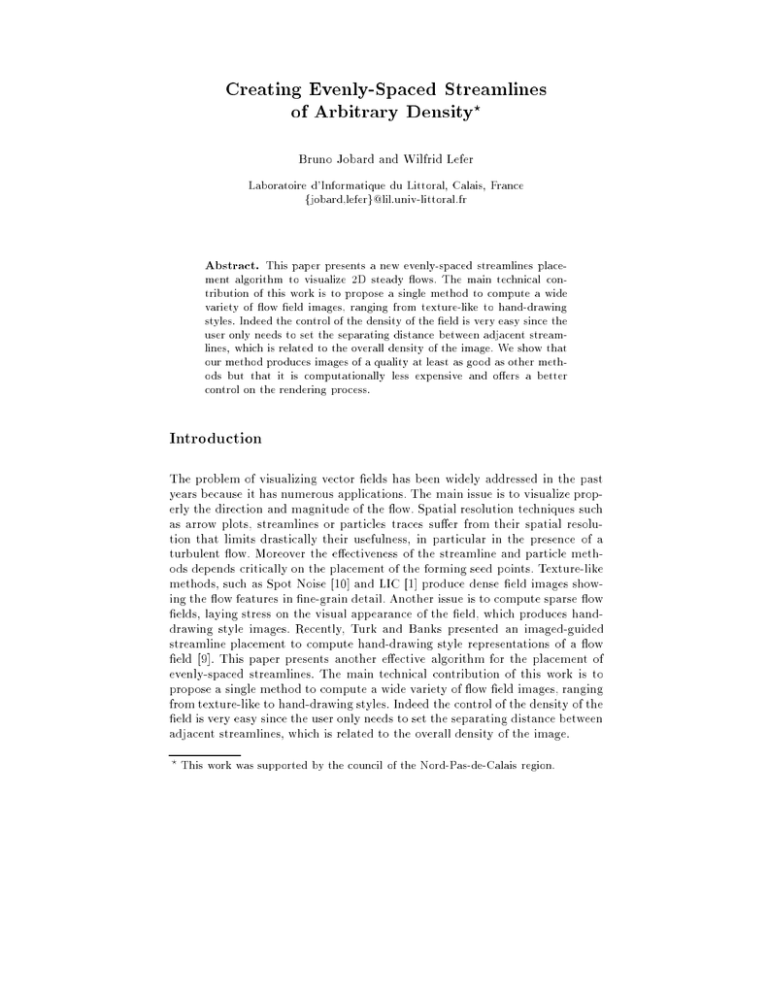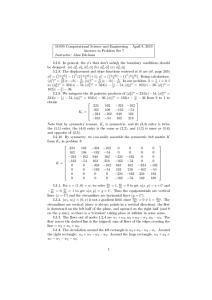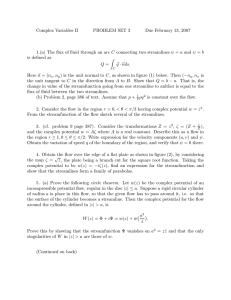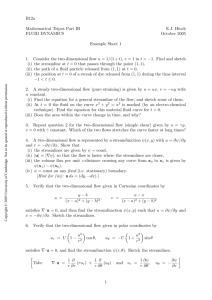Creating Evenly-Spaced Streamlines of Arbitrary Density?
advertisement

Creating Evenly-Spaced Streamlines
of Arbitrary Density?
Bruno Jobard and Wilfrid Lefer
Laboratoire d'Informatique du Littoral, Calais, France
fjobard,leferg@lil.univ-littoral.fr
Abstract. This paper presents a new evenly-spaced streamlines placement algorithm to visualize 2D steady ows. The main technical contribution of this work is to propose a single method to compute a wide
variety of ow eld images, ranging from texture-like to hand-drawing
styles. Indeed the control of the density of the eld is very easy since the
user only needs to set the separating distance between adjacent streamlines, which is related to the overall density of the image. We show that
our method produces images of a quality at least as good as other methods but that it is computationally less expensive and oers a better
control on the rendering process.
Introduction
The problem of visualizing vector elds has been widely addressed in the past
years because it has numerous applications. The main issue is to visualize properly the direction and magnitude of the ow. Spatial resolution techniques such
as arrow plots, streamlines or particles traces suer from their spatial resolution that limits drastically their usefulness, in particular in the presence of a
turbulent ow. Moreover the eectiveness of the streamline and particle methods depends critically on the placement of the forming seed points. Texture-like
methods, such as Spot Noise [10] and LIC [1] produce dense eld images showing the ow features in ne-grain detail. Another issue is to compute sparse ow
elds, laying stress on the visual appearance of the eld, which produces handdrawing style images. Recently, Turk and Banks presented an imaged-guided
streamline placement to compute hand-drawing style representations of a ow
eld [9]. This paper presents another eective algorithm for the placement of
evenly-spaced streamlines. The main technical contribution of this work is to
propose a single method to compute a wide variety of ow eld images, ranging
from texture-like to hand-drawing styles. Indeed the control of the density of the
eld is very easy since the user only needs to set the separating distance between
adjacent streamlines, which is related to the overall density of the image.
?
This work was supported by the council of the Nord-Pas-de-Calais region.
1 Related work
Visualizing a vector eld in a general manner requires high spatial resolution
techniques to properly render ne-grain details. Such methods generally yield
dense eld representations. However there are situations where a sparse density
image is needed, by instance to produce an illustration similar to those used to
enhance the purpose of text elds in a book. Methods proposed to visualize a
ow eld falls into these two categories: dense eld representations and handdrawing style.
The rst method for representing a ow eld with high spatial resolution has
been proposed by van Wijk [10]. The spot noise method creates a directional
texture by superimposing many ow-oriented ellipses. Each ellipse is generated
by projecting a spherical spot onto a surface and by advecting the spot with
the direction and magnitude of the vector eld at the projection point. This
amounts to the ow eld-controlled generation of a band-limited noise. Initially
straight, the spots are now bent along short streamlines to follow the curvature
of the vector eld [2]. An important feature of this method is the local control
on the generated image. More spots gives rise to more accuracy. With spot noise
the generation time depends on the number of spots used to generate the texture. Consequently, by setting the number of spots a trade-o can be obtained
between image quality and rendering time.
Another interesting method is the line integral convolution (LIC) proposed
by Cabral and Leedom [1] [4] [8]. A LIC texture is generated by convoluting an
input texture with a streamline-oriented one dimensional lter kernel. The images obtained with this technique are very eectives, showing more details than
the previously enumerated one. But this is obtained at the expense of computation. This computation cost is mainly due to the number of streamlines that
have to be computed, and let us notice that even with the fastLIC method [8],
several streamlines cover each single pixel of the resulting texture, giving rise to
frequent recomputations.
The image-guided streamline placement method proposed in [9] uses a stochastic mechanism to iterately rene the placement of the streamlines. First an initial
set of randomly placed streamlines is created. Then this set of streamlines is updated using three valid operations: (1) changing the position and/or length of
a streamline, (2) joining streamlines that nearly abut, and (3) creating a new
streamline to ll a gap. At each step of the renement process a small change, i.e.
a combination of the three operations mentioned above, is randomly performed.
An energy function consults a low-pass-ltered (blurred) version of the image
to measure the variation of energy between the current and the updated images and the modication is only accepted if the variation of energy if negative.
This method produces high quality images but the convergence is very slow and
obtaining a good visual appearance often requires several minutes for each image to be computed. Moreover this method is not suitable for dense eld images
because of the combinatorial explosion of the possible modications at each step.
The remainder of this paper is organized as follows. In section 2 we present
a method for eective user-controlled evenly-spaced streamlines placement. Section 3 describes the use of the method to produce hand-drawing style images
and we compare our approach with the image-guided streamline placement from
Turk and Banks. In section 4 we show how texture-like images can be obtained
and we discuss the advantages and drawbacks of this method compared to LIC.
We conclude and oer directions for future research in section 5.
Fig.1. (a) Long streamlines with seed points placed on a regular grid (left); (b) Same
ow eld computed using our streamline placement method (right)
2 Algorithm overview
The goal of this work is to produce long and evenly spaced streamlines in a single
pass. The basic principle of our algorithm is similar to a method presented by
Max et al. in [6]. The goal of their work was to cover a 3D surface (not necessary
tangential to the eld) with a set of streamlines. Once a seed point has been
selected in the eld, they make a streamline growing beyond that point backward and forward. The growing process is stopped when the streamline reaches
an edge of the surface, a singularity in the eld (source or sink) or becomes too
close to another streamline. The streamline is then divided into a set of small
segments of contrasting color and projected onto the surface. Although Max's
method was intended to visualize a ow on a 3D surface, it can be generalized
to all kinds of steady 2D eld.
We extend this work in the following manner. First we give a number of precisions concerning the implementation of the algorithm together with a couple
of optimizations. Second we show how the algorithm can be controlled by the
user to produce a wide range of ow elds images, ranging from hand-drawing
to LIC-like style.
An important feature of the algorithm is that it processes in a single pass
(as compared to Turk's progressive renement approach). To compute an image,
a number of streamlines are calculated until a user-xed density level has been
obtained. Computing a new streamline is achieved in the following manner. A
new seed point is chosen at a minimal distance apart from all existing streamlines. Then a new streamline is integrated beyond the seed point backward and
forward until either it goes too close from another streamlines or it leaves the 2D
domain over which the computation takes place. The algorithm ends when no
more valid seed point can be found. Figure 1b shows an image obtained with our
algorithm and gure 1a shows the same ow eld visualized using a distribution
of the seed points over a regular grid. The three following sections detail three
important points of the algorithm: the control of the distance between adjacent
streamlines, seed points selection and streamline integration.
2.1 Control of the separating distance
Density is a global feature of the eld. However we need to express it as a local
feature in order to have a local control on the texture generation. We express
the density as the distance between two adjacent streamlines. Let dsep be this
distance. Hence the control of the density of the eld is achieved by controlling that there is not any pair of streamlines apart from a distance lower than
dsep. This control occurs during the construction of each streamline. During the
construction, a new sample point is valid only if it is at a separating distance
greater than dsep. If it is not the case, the streamline is stopped in this direction (during construction streamlines grow in both directions independently). In
order to make the computation of the separating distance faster, rather than
computing the exact distance from the new seed point location to the streamline, we compute the distance from the seed point to the sample points along
the streamline. To make this approximation acceptable, the sample points on
a streamline must be evenly spaced and the distance between them must be
smaller than dsep. Thus, a new sample point is valid if the distance between
it and all the existing sample points is greater than the separating distance.
Since this test has to be computed for all the sample points, it must be as fast
as possible. To accelerate the computation of the distance, we use a cartesian
grid superposed to the vector eld domain, the width and height of a cell being
exactly dsep. Each cell contains a list of pointers to the sample points located
within the cell. Thus, given a new seed point location, the cell containing the
location is easily determined. Let us call this cell the local cell. The distance has
to be computed only for the sample points located either within the local cell or
within the eight cells surrounding the local cell. In practice, we have noticed that
an average of 5-7 distance computations is necessary to determine if a new sample point is valid or not. The denser is the grid, the less comparisons are required.
remark: Practically, we consider two important distances, dsep and dtest.
dsep is the separating distance given by the user. It represents the minimal
distance between seed points and streamlines. dtest is a percentage of dsep . It
corresponds to the minimal distance under which the integration of the streamline will be stopped in the current direction. We found dtest = 0:5 dsep gives
good visual result by producing long streamlines. For instance, images of Figure
2 have been calculated with two dierent values of dtest.
Fig.2. increasing dierence between dsep and
(left) d1test = 0:9 dsep; (right) d2test = 0:5 dsep
2.2 Seed points selection
dtest
lengthen streamlines;
When using streamlines for vector eld visualization, a common problem is to
select proper seed points for path tracking. Dovey proposed two approaches to
resample non-uniformly spaced grids in order to achieve an uniform density of
vector glyphs [3]. A vector eld is represented with short segments oriented by
the ow. In case of short streamlines or hedgehogs, the resulting image mainly
depends on the distribution and density of the seed points over the domain. In
case of long streamlines a constant density of seed points do not ensure a good
distribution of the streamlines.
In order to obtain a good visual appearance of the ow eld, an accurate seed
point selection has to be perform. The principle of our algorithm is to derive all
the seed points possible to nd from an existing streamline before trying with
another existing one. The proposed seed points are chosen at a distance d = dsep
from the sample points of each streamline. Our algorithm uses a queue to store
the newly created streamlines which are processed from the older one to the
more recently created one. The algorithm is given below.
Compute an initial streamline and put it into the queue
Let this initial streamline be the current streamline
Finished := False
Repeat
Repeat
Select a candidate seedpoint at d = dsep apart from the current streamline
Until the candidate is valid or there is no more available candidate
If a valid candidate has been selected Then
Compute a new streamline and put it into the queue
Else
If there is no more available streamline in the queue Then
Finished := True
Else
Let the next streamline in the queue be the current streamline
EndIf
EndIf
Until Finished=True
Figure 3 shows all the streamlines the algorithm has been able to derive from
the rst streamline for a given vector eld.
d
d
d
d
d
d
Fig.3. streamlines are derived from the rst (thick) one by choosing seed points (circles) at a distance d = dsep from it
Fig.4. Two seed points selection method with the same density of streamlines: (left)
random selection, (right) our selection method
For sparse illustrations choosing to start streamlines close to existing ones
gives better visual results than selecting seed points in a random fashion (see
gure 4) but is more time-consuming. For dense texture generation, the quality
of images produced with various seed point selection methods is quite similar.
2.3 Streamline integration
In order to measure a consistent separating distance between a point and a
streamline, sample points along a streamline must be evenly spaced (see section 2.1). Many integrators are able to produce such evenly spaced sequences of
sample points. They can be classied into three categories:
{ xed step size integrators such as Euler, Midpoint or Runge-Kutta methods
with normalized vector elds,
{ non constant or adaptive step size integrators with a post interpolation phase
such as cubic Hermite-interpolation, which deal with large distances between
neighboring sample points and curvature of the streamlines [8],
{ continuous integration methods such as DOPRI5, which is a fth order
Runge-Kutta integrator with adaptive step size monitoring and fourth order
error estimation and produces a dense output directly by using informations
gathered at each step of the integration [5].
At present we use the Midpoint integrator but future investigations will concern
the choice of a better integration method. In particular using an adaptive step
size integrator will decrease the number of integrations required, reducing overall
computation time.
a
b
c
d
e
f
Fig.5. Image comparisons for separating distances of 6%, 3% and 1.5% of image width;
left column: Image-guided placement; right column: Our streamline placement.
3 Hand-drawing style
Sparse illustrations of ows elds are the more interesting application of our
method. Turk et al. proposed a method to compute such a representation in
[9]. The method computes an initial set of streamlines which is then iterately
rened until the global energy of the image falls below a xed threshold or the
user stops the process. The images obtained with this method are of great quality
but the convergence of the iterative process is very slow and becomes much slower
when desired density increases. Moreover the energy function used to measure
the quality of the result is not directly related to the visual appearance of the
image, requiring the appreciation of the user to stop the process.
The advantage of our method as compared to Turk's one is that it processes in
a single pass, computing the nal image directly. Figure 5 shows the same ow
eld computed by Turk's method with various renement degrees and by our
method and table 1 gives computation times necessary to produce the dierent
images. We see that our method produces images of the same quality as Turk's
ones but is less time-consuming.
separating distance Image-guided placement Our placement algorithm
6% image width Fig 5a: stopped at 2 mn Fig 5b:
3% image width Fig 5c: stopped at 4 mn Fig 5d:
1.5% image width Fig 5e: stopped at 10 mn Fig 5f:
4 seconds
9 seconds
17 seconds
Table 1. Computation times on a MIPS R4600 Processor, 132Mhz with 32Mo. Image-
guided placement images and computation times were obtained with the Greg Turk's
original publicly available algorithm.
Fig. 6. Hand-drawing style images computed without and with the tapering eect
Tapering eect. As stated in section 2.1 the actual distance between stream-
lines is not constant. Since the density is related to the distance between streamlines, disparities of density may appear in the resulting image. To reduce this
visual artifact, Turk suggested to taper the ends of the streamlines by decreasing
the thickness of the lines as they go closer to another one. In case of Turk's
algorithm, this is achieved in a post-processing step. Our implementation allows
to directly include the tapering optimization during the growing process of each
streamline. The width of the streamline is computed using the following formula:
( 1:0
8d dsep
thicknessCoef = d ? dtest 8d < dsep ; thicknessCoef 2 [0; 1]
dsep ? dtest
where d is the distance to the closer streamline (see section 2.1 for the denition of the dierent distances).
Fig 6 shows the same image computed without and with the tapering eect.
Glyph mapping. Once the streamline placement has been computed, the
streamlines can be viewed as skeletons on which directional glyphs can be mapped.
Figure 7 shows an image obtained by mapping such kind of icons onto the computed streamlines. This enables to add a directional information in the eld.
Fig. 7. examples of illustrations with glyph mapping
4 Texture generation
By decreasing the separating distance dsep, the coverage of the streamlines becomes dense over the eld. To depict the tangential component of the ow in
a dense representation we have to dierentiate close streamlines to be able to
follow them over the eld. This is achieved by mapping a periodic intensity
function onto the streamline. Let us consider f(x) a function which associates
an intensity to every sample point on a streamline where x is the rank of the
sample point within the streamline. f will give the shape of the intensity wave
on the streamline. For instance, one may associate the two functions f1 and f2
given below:
x mod N
))
and
f
f1 (x) = 21 (1 + sin( 2x
2(x) =
N
N ?1
where N is the length of the period as a number of sample points.
f1 will give a smooth continuously increasing and decreasing intensity while
the modulo function f2 will produce discontinuous segments of increasing intensity in order to remove ambiguities about the orientation of the ow. Figures 8
and 9 show an image obtained using this pair of functions.
Fig.8. textures generated with the
(right) long period of f1
f1
function for intensity eects; (left) short and
The images obtained with our method look like LIC images. In fact our
algorithm is somehow a dual version of LIC. With LIC, for each pixel p of the
output image, one integrates a particle path centered on p forward and backward
and then averages intensities of the input texture pixels to get the intensity of the
pixel being calculated. In our method, we nd an optimal dense coverage of the
eld which minimizes the number of integrated streamlines and then associate
an intensity to each pixel of all the streamlines.
Fig.9. textures generated with the
(right) long period of f2
f2
function for intensity eects; (left) short and
Now let us point on the advantages of our method over LIC. The rst advantage is that our method does not require an input texture to process. With LIC a
problem arises when one want to change the length of the apparent streamlines.
In case of LIC, it is necessary to change the length of the convolution lter,
which gives rise to a computation overhead. It is stated in [1] that doubling the
length increases the computation time by a factor of four. Okada and Lane have
proposed another solution, which consists in executing the LIC algorithm twice,
the resulting image of the rst execution being used as the input of the second
execution [7]. This method results in lines which are more easily distinguishable
but it concentrates the pixels values in a narrow range of intensity, which decreases the global contrast. This eect can be removed by applying post-lters
to the nal image, but this is done at the expense of a computation overhead
(approximately by a factor of two).
With our approach we are able to change the length of the apparent streamlines
on demand by simply changing the length of the period of the function as described above, without recomputation of any streamline.
In the traditional LIC algorithm, a streamline integration and a line convolution are computed for each individual pixels, so most of the time is spent in
convolution and integration operations. Decreasing the number of streamlines
computed would greatly benet the LIC algorithm. Stalling and Hege proposed
the FastLIC algorithm which reduces the overall number of streamline computations by sharing the line integral convolution information of each streamline
with all the pixels it goes through [8].
With our approach, we compute the minimum number of streamlines necessary
to cover entirely the 2D area over which the eld is studied.
For instance, the computation of textures images of size 512 512 (such as gures 8 and 9) takes about 25 seconds on a R5000SC-64Mo based system. These
results have been obtained using a random seed points selection method and
a separating distance of 0:3%. As far as dense texture images are concerned, a
drawback of our method is the aliasing eect due to the drawing of adjacent
line segments of dierent colors. To remove this artifact we can smooth the nal
image by simply applying a blur lter.
5 Conclusion
We have presented an eective method to place long evenly-spaced streamlines
with an accurate control on the density of the nal image. By changing the
separating distance between streamlines we are able to produce from sparse to
dense representations of ow elds. We show that our method produces images
of a quality at least as good as other methods but that it is computationally less
expensive and oers a better control on the rendering process. Future investigations will concern a more ecient integrator, generalization to unsteady ows
and real time animation.
References
1. Brian Cabral and L. Leedom. Imaging vector elds using line integral convolution.
Computer Graphics, 27:263{272, jul 1993.
2. W. C. de Leeuv and Jarke J. van Wijk. Enhanced spot noise for vector eld visualization. In Proc. of Visualization '95, pages 233{239. IEEE Press, Los Alamitos,
CA, oct 1995.
3. Don Dovey. Vector plots for irregular grids. In Proc. of Visualization '95, pages
233{239. IEEE Press, Los Alamitos, CA, oct 1995.
4. Lisa K. Forsell. Visualizing ow over curvilinear grid surfaces using line integral
convolution. In Proc. of Visualization '94, pages 240{247. IEEE Press, Los Alamitos, CA, oct 1994.
5. E. Hairer, S. P. Nrsett, and G. Wanner. Solving Ordinary Dierential Equations
I - Nonsti Problems. Springer-Verlag, 1993.
6. Nelson Max, Roger Crawls, and Charles Grant. Visualizing 3D velocity elds
near contour surfaces. In Proc. of Visualization '94, pages 248{255. IEEE Press,
Los Alamitos, CA, oct 1994.
7. A. Okada and D. Lane. Enhanced line integral convolution with ow feature
detection. Technical Report NAS-96-007, NAS, jun 1996.
8. D. Stalling and H-C. Hege. Fast and resolution independent line integral convolution. Computer Graphics, 29:249{256, jul 1995.
9. Greg Turk and David Banks. Image-guided streamline placement. Computer
Graphics, 30:453{460, jul 1996.
10. Jarke J. van Wijk. Spot noise: Texture synthesis for data visualization. Computer
Graphics, 25(4):309{318, jul 1991.





